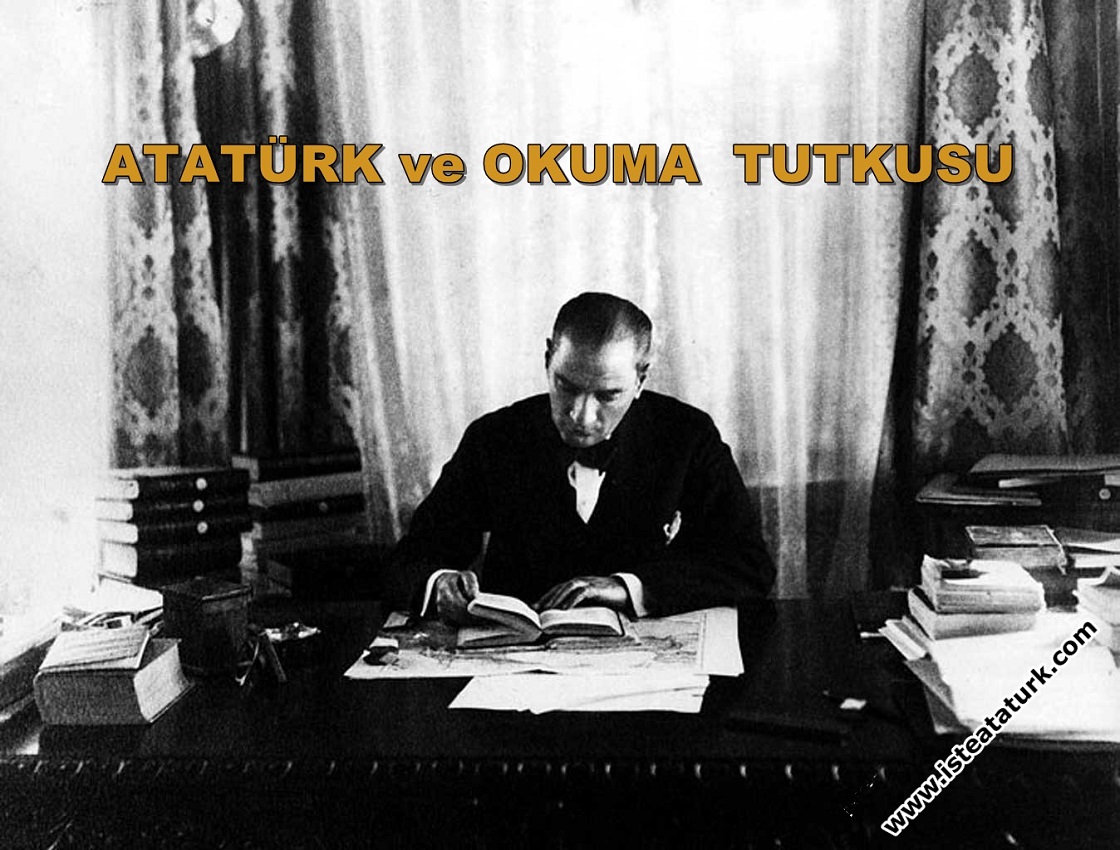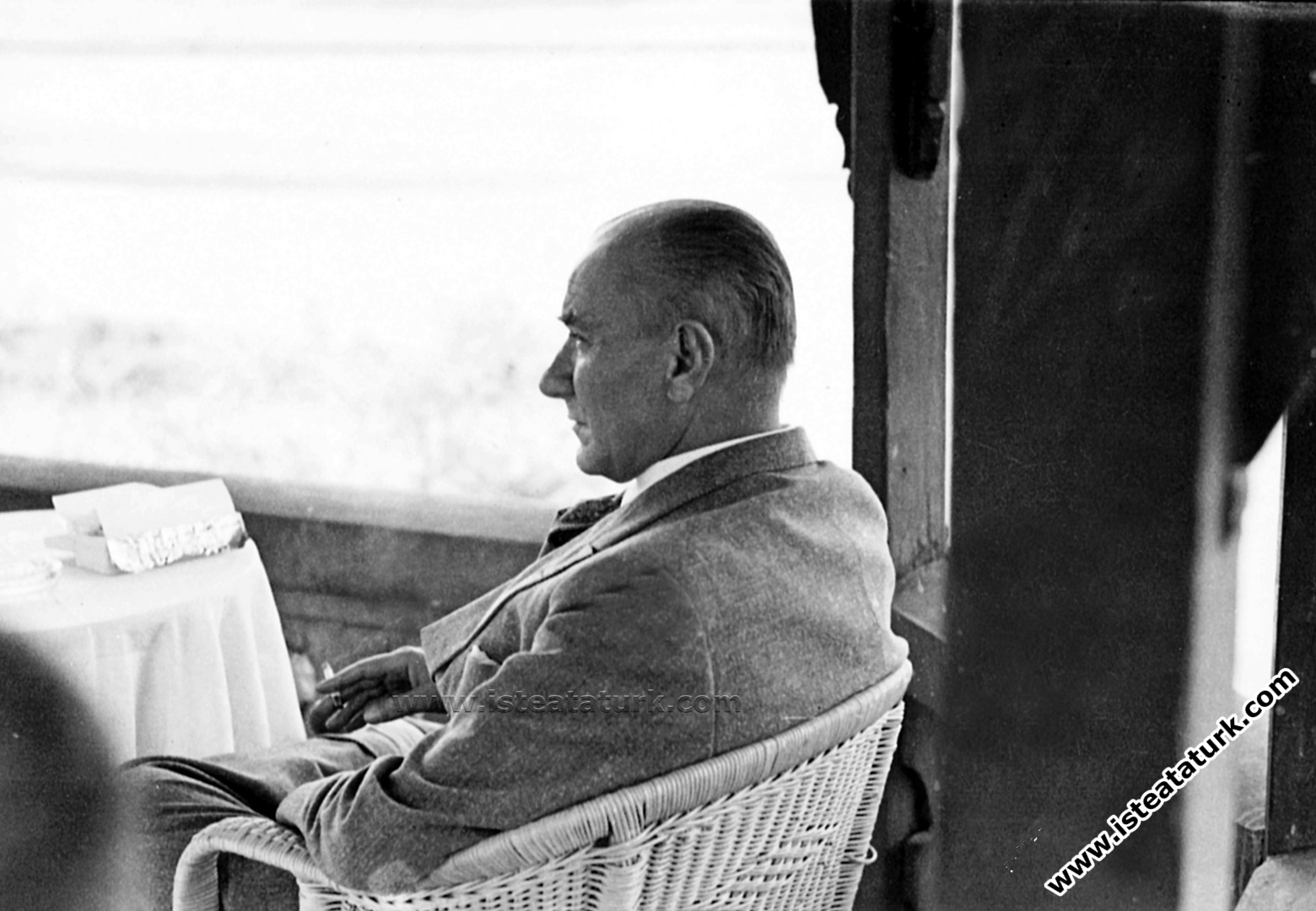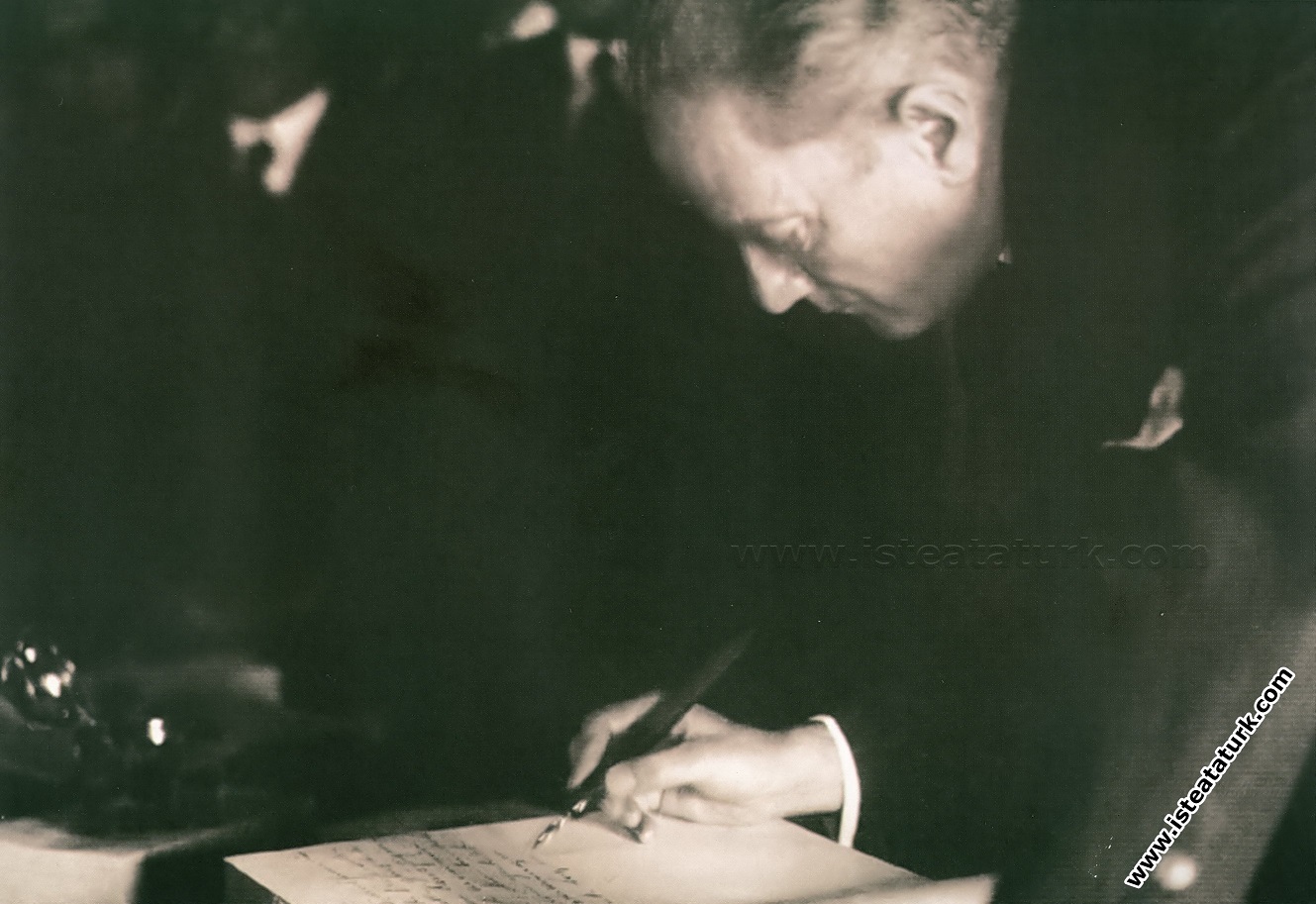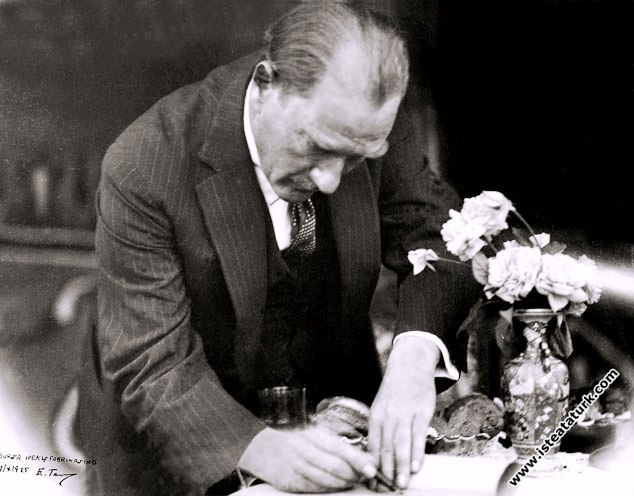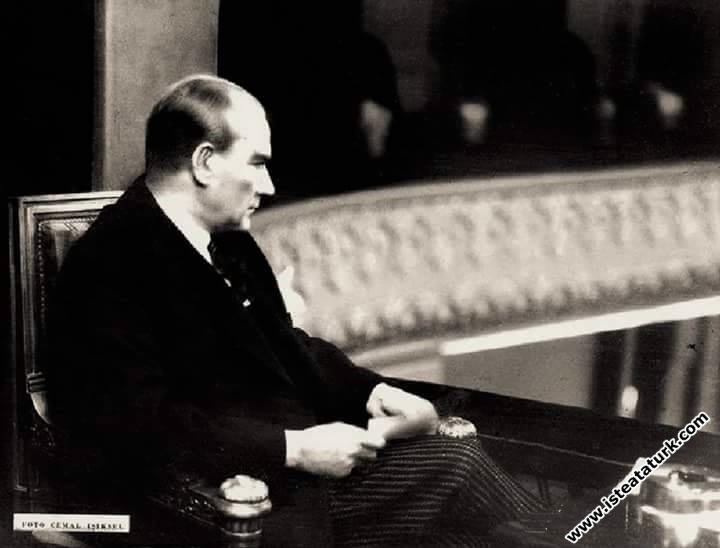
Atatürk, Science and Art
Character Size
Atatürk, Science and Art
ATATÜRK, SCIENCE AND ART
Atatürk's Thoughts and Suggestions on Science and Fine Arts and their application principles. The main purpose of these speeches is to present his thoughts and principles in the reorganization of the institutions and organizations he established in this regard, in the Atatürk Revolutions in the birth and establishment of Turkey, in the subjects of Science, Culture and Fine Arts, and to reveal to our young generations the ideas and principles of these new organizations as a person who lived those days. the difficulties in realizing it and the foresight, perseverance and will that the great Atatürk showed in overcoming these difficulties. According to Atatürk, “abolishing the institutions that have left the Turkish nation behind in the last centuries, ensuring the progress of the nation in accordance with the highest modern requirements, and establishing new and modern institutions” refers to the revolution. The main aim is to become a modern, civilized society. After the great victory, a new order began to be established in place of the old order, which was destroyed and deteriorated; According to the needs of social life, society and state life were given a new shape and order. Atatürk, who said, "It is vital to walk and succeed on the path of modernity," was in an effort to establish an advanced mentality that would raise our nation above the level of contemporary civilization. For this purpose, radical changes, revolutions (revolutions) made in the life of the state and society followed each other. Atatürk's most important revolutions are briefly as follows: He was in an effort to establish an advanced mentality that would raise our nation above the level of contemporary civilization. For this purpose, radical changes, revolutions (revolutions) made in the life of the state and society followed each other. Atatürk's most important revolutions are briefly as follows: He was in an effort to establish an advanced mentality that would raise our nation above the level of contemporary civilization. For this purpose, radical changes, revolutions (revolutions) made in the life of the state and society followed each other. Atatürk's most important revolutions are briefly as follows:
I- Revolutions Made in the Political Field
1. Abolition of the Sultanate (1 November 1922),
2. Proclamation of the Republic (29 October 1923),
3. Abolition of the Caliphate (3 March 1924),
II-Revolutions Made in Social Life:
1. The Law on the Wearing of Hats (25 November 1925),
2. Law on Closure of Lodges, Zaviyes and Tombs and prohibition and abolition of tombs and certain titles (30 November 1925),
3. Law on the acceptance of international figures (20 May 1928),
4. Adoption of the laws on the International (International) Clock and Calendar (26 December 1925), With these accepted laws, the Hijri and Rumi calendar application was abolished and the Gregorian calendar was replaced by the International clock system instead of the Alaturka clock.
5. Law of Measures (26 March 1931). With this law, meters, kilograms and liters used by civilized nations were accepted as measurement units.
6. Law on the abolition of nicknames and titles (26 November 1934),
7. Law on not wearing certain clothes (November 26, 1934)
8. Surname Law (21 June 1934),
9. The law on giving the surname of Gazi Mustafa Kemal to our President (Atatürk). (24 November 1934),
10. Women's attainment of civil and political rights:
a-) Rights Provided by Civil Law,
b-) Adoption of the law granting women the right to vote and be elected in municipal elections (April 3, 1930), c-) Granting the right to vote and be elected as a member of the parliament with the amendment made in the Constitution (5 December 1934),
III- Revolutions Made in the Field of Law:
Abolition of the 1. Serial Courts and the establishment of the new Courts Organization (April 8, 1924), 2. The Turkish Civil Code (February 17, 1926), separated from the Religious Law system and the implementation of the secular contemporary legal system began.
IV- Revolutions Made in the Field of Education and Culture:
1. The Law of Unification of Education (3 March 1924),
With this law, all science and education institutions in Turkey were connected to the Ministry of National Education.
2. Law on Adoption and Application of New Turkish Letters (1 November 1928),
3. The establishment of the Turkish Historical Research Society (12 April 1931).
The Society was later renamed the Turkish Historical Society (October 3, 1935).
With the establishment of the institution, which expresses a new view of history in the field of culture, the understanding of the history of the Ummah has passed from the understanding of the history of the nation. Establishment of Turkish Language Investigation Society (12 July 1932). The Society was later renamed the Turkish Language Institution (24 August 1936). The aim of the institution is to reveal the beauty and richness of the Turkish language and to raise it to a height worthy of its value among the languages of the world.
Atatürk in 1936;
“The foundation of the Turkish Republic is culture and we will raise our national culture above the level of contemporary civilization.” In his words, he once again emphasized how much he cares about this issue. Atatürk's cultural policy aimed to unite Turkish citizens under a single culture and thereby to level them with the cultures of other civilized nations. Atatürk believed that it was possible to harmonize Turkish traditions with Western modernity. The priority for him was the modernization of the Turkish nation. According to Atatürk, in order for the state to be based on a solid foundation, the thoughts and feelings of the society should be parallel to the Republic and the progressive goals of the Republic. The State of the Republic of Turkey, under the leadership of Atatürk, immediately after the proclamation of the Republic in 1923 and the reforms mentioned above.
As we mentioned above, Atatürk's contribution to the language revolution was in two ways:
The first of these is the introduction of the new Turkish Alphabet in 1928, and the second is the change of words that are incomprehensible to Turks who cannot understand most of the speech. The introduction of the New Turkish Alphabet, the second is the change of words. The New Turkish Alphabet was the most appropriate of the alphabets used in Turkish software. Thus, while the rate of literate people was 9% in 1924, it increased to 60% in 1975. The only reason for this rise is the simplicity and simplicity of the new Turkish Alphabet and the educational campaign initiated by Atatürk. This is one of the most important reasons why we should respect and admire the great leader Atatürk, who changed the destiny of Turkish society and carried a nation from the border of extinction to the light. Right after the establishment of the Turkish Language Investigation Society in July 1932, “The Turkish Nation, which knows how to protect its region and its honorable independence, The aim of Atatürk, who liberated the language revolution with the words "the language should be freed from the bondage of foreign languages," is to take measures that will root, develop and spread the love and awareness of Turkish language in new generations, taking into account the unifying and integrating features of the Turkish language, which is one of the basic elements of our national existence, and to make it widespread. strongly envisaged the conduct of studies on the subject. Immediately after the alphabet change, Mustafa Kemal Atatürk turned his attention to history. Atatürk, who sincerely believed in the greatness and superior civilizational abilities of the Turkish nation, believed that in order for the Turkish nation to rise to the level of the most civilized nations, it was necessary to first know its history and to learn its history by researching it from the first sources. In this direction, Atatürk, issues related to Turkish history,
Atatürk wanted to spread all branches of science and art to the most remote villages of the country. The most important means of achieving this goal were public houses and public chambers. public houses; It is designed to raise people physically, mentally and intellectually and to fill their free time with entertainment and cultural activities. Public houses have become an important place for the exhibition of various performing arts and for the Turkish people to benefit from them.
In the public houses conferences, lectures, plays, meetings, libraries, publications, sports activities, concerts and exhibitions were provided, as well as guidance on various issues. The foundations for the establishment of a State Theater in Turkey were laid during the time of Atatürk, who saw the theater as an important element in the modernization of the country.
The most important step in this direction is for women to enter the theater profession. Regarding this issue, Atatürk assured that Turkish women could freely appear on the stage. Turkish women took the stage for the first time in Vedat Orfi's musical comedy “Balo Kaçakları” in 1923, and since then, the way has been paved for countless talented Turkish actresses, producers and directors.
On November 1, 1936, Atatürk said at the opening of the Turkish Grand National Assembly: “I would like to revive your interest in fine arts. It is a great pleasure for me to remind you that a conservatory and a theater academy have been opened in Ankara. The interest and effort of the Public Council for each institution of fine arts will affect the humane and civilized life of the nation and the increase in national production. Atatürk has clearly revealed his ideas especially in the field of music. These ideas about music were also used to inform and guide artists in other fields. In his speech at the National Assembly on November 1, 1934, Atatürk emphasized that how much a country has changed can be measured by the degree it receives in music.
Some turning points in contemporary Turkey's music history can be listed as follows.
1. 1924 - The Palace Band is renamed the State Orchestra
2. 1924- Music Teachers Training School was established. This school later turned into the State Conservatory.
3. 1926- Young Musicians begin to collect folk compositions from traditional sources. The foundations for this were created by compilers such as Adnan Saygun, Ulvi Cemal Erkin and Halil Bedif Yonken.
4. In 1927, the State began to select young talents to study abroad with a state scholarship.
5. 1932 - Foreign Musicians, teachers, conductors and composers were invited to Turkey. Among them were masters such as Joseph Marx., Paulttin de Mith, Bela Bartok and Eduward Zuekmayer.
Again in 1934, with the initiative of Atatürk, to honor the visits of the Shah of Iran to Turkey, the play "Özsoy", which symbolizes the Iranian-Turkish friendship as a fairy tale, was composed as an opera by Adnan Saygun with the name "Feridun", the first and most important step in the establishment of Turkish opera. has been. Addressing the artists in Adana on March 16, 1923, Atatürk said: “Some basic works are needed to keep a nation alive, and you should know that one of the most important of these basic works is art. If a nation lacks art and artists, it means there is no full life. Such a nation is like a person with a lame foot, a lame arm, a crippled, limping person. Even what I said is not enough to indicate what I want to say. One of the nation's lifeblood artless rest is cut off.
In a speech he made in 1935, Atatürk said, “A nation that cannot paint, a nation that does not do what science requires, must admit that that nation has no place in the path of progress. However, our nation will advance with its true qualities.” In his words, he stated the importance he gave to the arts of painting and sculpture in Turkey and made it possible for these arts to spread to large masses by entering the far corners of Turkey. Established in 1883 as the “Industry Nefise Mektebi Alisi” during the Ottoman period, the college was transformed into a “Fine Arts Academy” in 1926 by the order of Atatürk and moved to one and then two of the double palaces in Fındıklı. Istanbul Painting and Sculpture Museum in Dolmabahçe Palace, which was opened by Atatürk on September 10, 1937,
The movement to have Monuments and Sculptures built in the Republican era started in 1925. At that time, foreign sculptors worked because there were no Turkish sculptors in Turkey. 1925 An attempt was made to build a victory monument in Ankara Ulus Square. A competition was opened by Ankara Municipality. Viennese sculptor H.Krippel wins the first place. After Ankara, another statue of Atatürk was commissioned by the same sculptor in Sarayburnu Park in Istanbul. After that, Krippel made Atatürk statues in Konya and Samsun. The Atatürk monument in Sarayburnu was opened on October 3, 1926. Italian Sculptor Canomika made in 9 September Atatürk monuments in İstanbul, Taksim and İzmir. After these first Monument-sculptures, Turkish Sculptors will start to erect Monuments and Sculptures. These are our sculptors: Zühtü Müridoğlu, Nejat Sürel,
Urbanism and Architecture in Turkey in the Atatürk Era:
In the proclamation days of the Republic, urbanism and architectural works in our country were completely stagnant. The only architecture school, Sanayi Nefise Mektebi Alisi, was founded in 1883 by Painter Osman Hamdi Bey. Great Atatürk said in 1923: “If a nation lacks art and artists, it cannot have a full life. Such a nation is like a person with a lame foot, a lame arm, a crippled and sick person. Even this word is not enough to express what I mean. A nation without art would have severed one of its vital veins.” Mustafa Necati Bey, who started his duty as the Ministry of National Education in 1925, said in his speech in 1926: “I felt the need to take precautions on fine arts as well. Sanayi Nefise Alisi School was transformed into the Academy of Fine Arts. In 1926, the college named “Fine Arts Academy” was moved to Hatice Sultan Palace in Fındıklı and later on, it was turned into a rather large Academy of Fine Arts by adding the other palace (former Faculty of Letters) next to it and combining the gaps, and in 1982 it was transferred to Mimar Sinan University. there is the past. Painter Namık İsmail became the director of the Academy of Fine Arts in June 1927. prof. Egli was appointed as the Head of the Architecture Department of the Academy in 1930. Meanwhile, Alisi from the Engineering School turned into the Graduate School of Engineering and became Istanbul Technical University in 1943. Yıldız Şimendifer Technicians school was transformed into Yıldız Engineering and Architecture Academy and Yıldız Technical University in 1982.
After Ankara became the capital during Atatürk's reign, German Urban Planning Expert Jansen organized Ankara's urban planning projects and this project was implemented in Ankara. Meanwhile, Australian Architect Clemense Holz Meister has designed Atatürk's Presidential mansion in Çankaya, the Turkish Grand National Assembly building and many ministries in Ankara. German Architect Prof. Paul Bonatz, on the other hand, built the Şükrü Saraçoğlu neighborhood and the State Opera House in Ankara. Brunio Taut, who fled Germany from the Nazi regime in 1933, built the Faculty of Language, History and Geography Building in Ankara and later came to Istanbul Fine Arts Academy as a professor. As it can be understood from what I have told, in the period of Atatürk, in Ankara and Istanbul, both in terms of urbanism and architecture, from Europe, especially Germany, Experts were brought in from Austria and France. In Istanbul, French Urban Planning Expert Henry Prost was brought. Before the era of Atatürk, Balyans in Istanbul, Mimari Vallaury (Senior Umumiye Building) later turned into Istanbul High School. From Turkish Architects; prof. Sedat Hakkı Eldem; prof. Emin Onat; prof. Seyfi Arkan; prof. Kemal Ahmet He achieved fame and kept the generations of architects alive. prof. Eldem and Prof. Onat in Istanbul, Istanbul University Faculty of Arts and Sciences and Istanbul Palace of Justice Buildings, Prof. Onat made the Atatürk Anıtkabir with Associate Professor Orhan Arda, and Prof. Seyfi Arkan, on the other hand, gave Florya Deniz Köşküm to Atatürk in Istanbul and İller Bankası in Ankara and Prof. Kemal Ahmet Aru in Ist. Levent I, II, III and IV. cü Neighborhoods, Etiler and his friends built the Sheraton Hotel with architects. French Urban Planning Expert Henry Prost was brought in. Before the era of Atatürk, Balyans in Istanbul, Mimari Vallaury (Senior Umumiye Building) later turned into Istanbul High School. From Turkish Architects; prof. Sedat Hakkı Eldem; prof. Emin Onat; prof. Seyfi Arkan; prof. Kemal Ahmet He achieved fame and kept the generations of architects alive. prof. Eldem and Prof. Onat in Istanbul, Istanbul University Faculty of Arts and Sciences and Istanbul Palace of Justice Buildings, Prof. Onat made the Atatürk Anıtkabir with Associate Professor Orhan Arda, and Prof. Seyfi Arkan, on the other hand, gave Florya Deniz Köşküm to Atatürk in Istanbul and İller Bankası in Ankara and Prof. Kemal Ahmet Aru in Ist. Levent I, II, III and IV. cü Neighborhoods, Etiler and his friends built the Sheraton Hotel with architects. French Urban Planning Expert Henry Prost was brought in. Before the era of Atatürk, Balyans in Istanbul, Mimari Vallaury (Senior Umumiye Building) later turned into Istanbul High School. From Turkish Architects; prof. Sedat Hakkı Eldem; prof. Emin Onat; prof. Seyfi Arkan; prof. Kemal Ahmet He achieved fame and kept the generations of architects alive. prof. Eldem and Prof. Onat in Istanbul, Istanbul University Faculty of Arts and Sciences and Istanbul Palace of Justice Buildings, Prof. Onat made the Atatürk Anıtkabir with Associate Professor Orhan Arda, and Prof. Seyfi Arkan, on the other hand, gave Florya Deniz Köşküm to Atatürk in Istanbul and İller Bankası in Ankara and Prof. Kemal Ahmet Aru in Ist. Levent I, II, III and IV. cü Neighborhoods, Etiler and his friends built the Sheraton Hotel with architects. Before the era of Atatürk, Balyans in Istanbul, Mimari Vallaury (Senior Umumiye Building) later turned into Istanbul High School. From Turkish Architects; prof. Sedat Hakkı Eldem; prof. Emin Onat; prof. Seyfi Arkan; prof. Kemal Ahmet He achieved fame and kept the generations of architects alive. prof. Eldem and Prof. Onat in Istanbul, Istanbul University Faculty of Arts and Sciences and Istanbul Palace of Justice Buildings, Prof. Onat made the Atatürk Anıtkabir with Associate Professor Orhan Arda, and Prof. Seyfi Arkan, on the other hand, gave Florya Deniz Köşküm to Atatürk in Istanbul and İller Bankası in Ankara and Prof. Kemal Ahmet Aru in Ist. Levent I, II, III and IV. cü Neighborhoods, Etiler and his friends built the Sheraton Hotel with architects. Before the era of Atatürk, Balyans in Istanbul, Mimari Vallaury (Senior Umumiye Building) later turned into Istanbul High School. From Turkish Architects; prof. Sedat Hakkı Eldem; prof. Emin Onat; prof. Seyfi Arkan; prof. Kemal Ahmet He achieved fame and kept the generations of architects alive. prof. Eldem and Prof. Onat in Istanbul, Istanbul University Faculty of Arts and Sciences and Istanbul Palace of Justice Buildings, Prof. Onat made the Atatürk Anıtkabir with Associate Professor Orhan Arda, and Prof. Seyfi Arkan, on the other hand, gave Florya Deniz Köşküm to Atatürk in Istanbul and İller Bankası in Ankara and Prof. Kemal Ahmet Aru in Ist. Levent I, II, III and IV. cü Neighborhoods, Etiler and his friends built the Sheraton Hotel with architects. Sedat Hakkı Eldem; prof. Emin Onat; prof. Seyfi Arkan; prof. Kemal Ahmet He achieved fame and kept the generations of architects alive. prof. Eldem and Prof. Onat in Istanbul, Istanbul University Faculty of Arts and Sciences and Istanbul Palace of Justice Buildings, Prof. Onat made the Atatürk Anıtkabir with Associate Professor Orhan Arda, and Prof. Seyfi Arkan, on the other hand, gave Florya Deniz Köşküm to Atatürk in Istanbul and İller Bankası in Ankara and Prof. Kemal Ahmet Aru in Ist. Levent I, II, III and IV. cü Neighborhoods, Etiler and his friends built the Sheraton Hotel with architects. Sedat Hakkı Eldem; prof. Emin Onat; prof. Seyfi Arkan; prof. Kemal Ahmet He achieved fame and kept the generations of architects alive. prof. Eldem and Prof. Onat in Istanbul, Istanbul University Faculty of Arts and Sciences and Istanbul Palace of Justice Buildings, Prof. Onat made the Atatürk Anıtkabir with Associate Professor Orhan Arda, and Prof. Seyfi Arkan, on the other hand, gave Florya Deniz Köşküm to Atatürk in Istanbul and İller Bankası in Ankara and Prof. Kemal Ahmet Aru in Ist. Levent I, II, III and IV. cü Neighborhoods, Etiler and his friends built the Sheraton Hotel with architects. prof. Seyfi Arkan, on the other hand, gave Florya Deniz Köşküm to Atatürk in Istanbul and İller Bankası in Ankara and Prof. Kemal Ahmet Aru in Ist. Levent I, II, III and IV. cü Neighborhoods, Etiler and his friends built the Sheraton Hotel with architects. prof. Seyfi Arkan, on the other hand, gave Florya Deniz Köşküm to Atatürk in Istanbul and İller Bankası in Ankara and Prof. Kemal Ahmet Aru in Ist. Levent I, II, III and IV. cü Neighborhoods, Etiler and his friends built the Sheraton Hotel with architects.
Architects, who were sent to Europe during the Atatürk period and grew up there, were appointed as lecturers to the Fine Arts Academy, Istanbul Technical University and Yıldız Academy and rendered great services to Turkey.
In conclusion: Our history of national independence and revolution consists of three phases.
First: “Liberation” Second, “Establishment”, and third, “Development” periods that have continued until today.
First Period: Atatürk's military aspect is his commander aspect. With this aspect, Atatürk started the War of Independence and saved Turkey from the invaders by defeating all the enemies that occupied the country at that time, one by one.
Second Period: It is the direction of Atatürk's statesmanship. He was meticulously law-abiding. It resulted in the establishment of the Turkish Grand National Assembly and the proclamation of the Republic.
Third period: With his revolutionary, leader, artist and scientist personality.
“The foundation of the Turkish Republic is culture.”
“We will raise our national culture above the level of contemporary civilization”
“As Turkish children get to know their ancestors, they will find the strength to do bigger things.”
“One of the historical qualities of the Turkish Nation is to love Fine Arts and to rise in it.”
“The truest guide for everything in the world, for materiality, for spirituality, for life, for others, is science.”
“Teachers around the world are the most altruistic and revered elements of the human community.”
Atatürk, who said his aphorisms, died on November 10, 1938.
Atatürk's Mausoleum in Ankara, as a result of a competition Prof. The construction of their project, which was won by Emin Onat and Orhan Arda and concluded in 1943, started in 1944 and the Anıtkabir was finished on November 10, 1953, and Atatürk's temporary tomb was taken from the Ankara Ethnography Museum and transferred to the Eternal Grave.
In the early times of the Ottoman period before the Atatürk era, miniatures were made instead of painting. Osman Hamdi Bey, who went to foreign countries (especially to France) and studied painting in the Ottoman period, founded the Sanayi Nefise Mektebi Alisi in 1883. Osman Hamdi Bey and his friends, such as Hüseyin Zekai Şeker, Ahmet Pasha, Süleyman Seyit, Hoca Ali Rıza, Şevket Dağ Naturalist painters continued the Floor Naturalism of their teacher Leon Gerome in France.
In the next period, the imperialist movement dominated and some of the lives of valuable painters such as Çallı İbrahim, Nazmi Ziya, Avni Lifij passed during the Atatürk period.
In the following period: Seref Akdik, Avni Arbaş, Nurullah Berk, Sabri Berkel, Şefik Bursalı, Mahmut Cüda, İbrahim Çallı, Şevket Dağ, Cevat Dereli, Halil Dikmen, Fehraman Duran, Devrim Erbil, Dinçer Erimez, Turan Erol, Bedri Rahmi Eyüboğlu, Our famous painters such as Eren Eyüboğlu, Neşet Günal, Namık İsmail, Zeki Faik İzer, Edip Hakkı Köseoğlu, Avni, Fikret Mualla, Hikmet Onat, Ayatollah Sümer, Cemal Tollu, Eşref Üren, thanks to Atatürk's reform in Fine Arts. They grew up and became famous. The Atatürk ports of İbrahim Çallı, Feyhaman Duran, Namık İsmail and Edip Hakkı Köseoğlu are famous. Architects, sculptors and other artists working in the construction of Atatürk's Mausoleum were trained under Atatürk's direction. This shows that the Great Atatürk Mausoleum was built with his own ideas.
NOTE: This conference was given in Edirne on behalf of Atatürk Research Center on 17 December 2002.
Prof. Dr. Muhteşem Giray*
*Director of Haliç University Ataturk's Principles and Revolution History Research and Application Center
Source: ATATÜRK ARAŞTIRMA MERKEZİ DERGİSİ, Sayı 54, Cilt: XVIII, Kasım 2002
